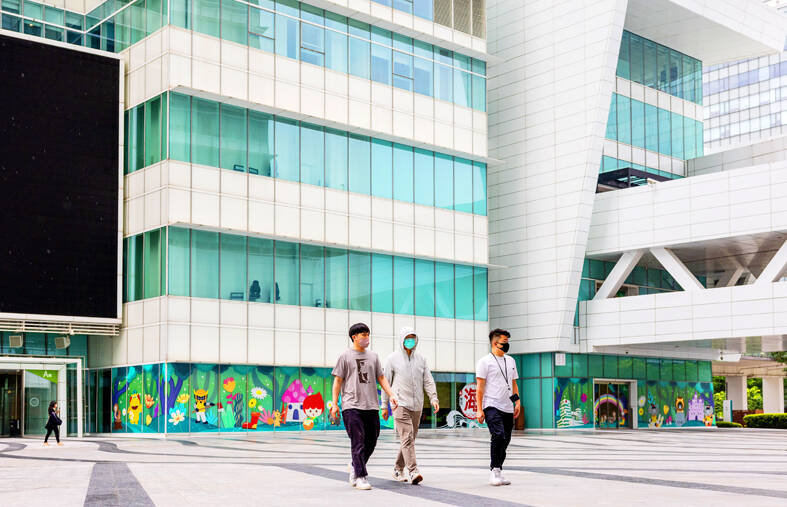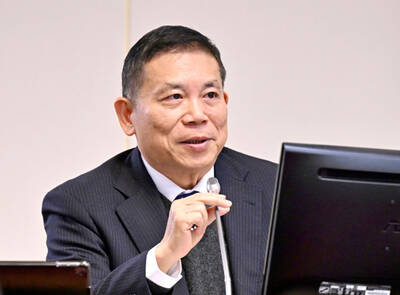The unemployment rate last month edged down 0.01 percentage points from the previous month to 3.38 percent, the lowest figure for March in 24 years, the Directorate-General of Budget, Accounting and Statistics (DGBAS) said yesterday.
The figure was also 0.18 percentage points lower than a year earlier, as more first-time jobseekers landed positions and fewer people lost jobs due to the end of seasonal or temporary work, the agency said in a report.
After seasonal adjustments, the unemployment rate was flat from the previous month at 3.40 percent, also the lowest in 24 years, the report said.

Photo: CNA
To comply with the International Labor Organization’s requirement, the DGBAS also reported the unemployment rate for the past four weeks at 3.49 percent, an increase of 0.07 percentage points from a month earlier.
For the first three months of the year, the unemployment rate was 3.36 percent, down 0.17 percentage points from a year earlier, the report said.
“As career switchers continue to land jobs, the unemployment rate this month is expected to fall further,” the Liberty Times (the Taipei Times’ sister newspaper) quoted DGBAS Census Department Deputy Director Chen Hui-hsin (陳惠欣) as saying yesterday.
The number of unemployed people last month fell by 1,000 sequentially to 405,000, as the number of first-time jobseekers that failed to land positions decreased by 2,000 monthly and people who lost their jobs due to the end of seasonal or temporary work also fell by 2,000, the report said.
Meanwhile, the number of people employed increased by 9,000 from the previous month to 11.581 million last month, with those in domestic services rising by 5,000 and industrial and agricultural sectors also increasing by 3,000 and 1,000 respectively, it added.
The average unemployment period last month rose slightly to 21.3 weeks, as it took first-time jobseekers 24.9 weeks to find work, while others spent 20.4 weeks to land one, the report said.
The number of people who were unemployed for more than a year grew by 2,000 from the previous month to 49,000, but dropped by 2,000 from a year earlier, it said.
Overall, the labor market stabilized, with the number of employed people standing at 11.58 million in the first three months, an increase of 96,000 from the same period of last year, while the number of unemployed people decreased by 17,000 to 403,000 over the period, the report said.
By demographic breakdown, people aged 20 to 24 had the highest unemployment rate at 11.41 percent in the first three months, followed by those aged 15 to 19 at 8.36 percent and those aged 25 to 29 at 5.82 percent, while the jobless rate for older people aged 45 to 64 was the lowest at 2.14 percent, it said.
In the first quarter, university graduates had the highest unemployment rate at 4.59 percent, followed by high-school graduates at 3.09 percent, while people with junior-high school or lower education had the lowest jobless rate of 2.7 percent, the report added.

UNCERTAINTY: Innolux activated a stringent supply chain management mechanism, as it did during the COVID-19 pandemic, to ensure optimal inventory levels for customers Flat-panel display makers AUO Corp (友達) and Innolux Corp (群創) yesterday said that about 12 to 20 percent of their display business is at risk of potential US tariffs and that they would relocate production or shipment destinations to mitigate the levies’ effects. US tariffs would have a direct impact of US$200 million on AUO’s revenue, company chairman Paul Peng (彭雙浪) told reporters on the sidelines of the Touch Taiwan trade show in Taipei yesterday. That would make up about 12 percent of the company’s overall revenue. To cope with the tariff uncertainty, AUO plans to allocate its production to manufacturing facilities in

TAKING STOCK: A Taiwanese cookware firm in Vietnam urged customers to assess inventory or place orders early so shipments can reach the US while tariffs are paused Taiwanese businesses in Vietnam are exploring alternatives after the White House imposed a 46 percent import duty on Vietnamese goods, following US President Donald Trump’s announcement of “reciprocal” tariffs on the US’ trading partners. Lo Shih-liang (羅世良), chairman of Brico Industry Co (裕茂工業), a Taiwanese company that manufactures cast iron cookware and stove components in Vietnam, said that more than 40 percent of his business was tied to the US market, describing the constant US policy shifts as an emotional roller coaster. “I work during the day and stay up all night watching the news. I’ve been following US news until 3am

Taiwan will prioritize the development of silicon photonics by taking advantage of its strength in the semiconductor industry to build another shield to protect the local economy, National Development Council (NDC) Minister Paul Liu (劉鏡清) said yesterday. Speaking at a meeting of the legislature’s Economics Committee, Liu said Taiwan already has the artificial intelligence (AI) industry as a shield, after the semiconductor industry, to safeguard the country, and is looking at new unique fields to build more economic shields. While Taiwan will further strengthen its existing shields, over the longer term, the country is determined to focus on such potential segments as

COLLABORATION: Given Taiwan’s key position in global supply chains, the US firm is discussing strategies with local partners and clients to deal with global uncertainties Advanced Micro Devices Inc (AMD) yesterday said it is meeting with local ecosystem partners, including Taiwan Semiconductor Manufacturing Co (TSMC, 台積電), to discuss strategies, including long-term manufacturing, to navigate uncertainties such as US tariffs, as Taiwan occupies an important position in global supply chains. AMD chief executive officer Lisa Su (蘇姿丰) told reporters that Taiwan is an important part of the chip designer’s ecosystem and she is discussing with partners and customers in Taiwan to forge strong collaborations on different areas during this critical period. AMD has just become the first artificial-intelligence (AI) server chip customer of TSMC to utilize its advanced